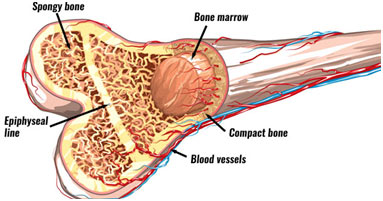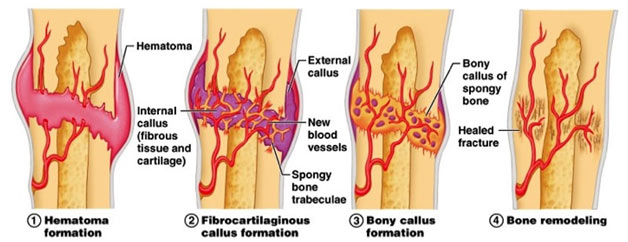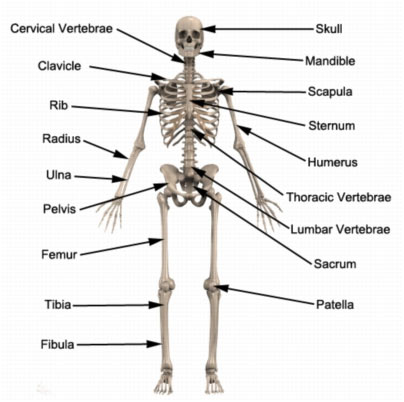Bones in Human
Bones are more than simply the scaffolding that holds the body together. Bones come in all shapes and sizes and have many functions.
In this article, we describe their function, what they are made from, and the kinds of cells involved.
At birth, we have around 270 soft bones. As we grow, some of these fuses.
As soon as we reach adulthood, we have 206 bones. They range in size from the tiniest present in the middle ear to the largest that forms our thigh.
The body has an amazing range of different bones, a lot of which you can find on yourself or on a skeleton.
The human skeleton is comprised of the following bones:
- Skull– including the jaw bone
- Spine– cervical, thoracic and lumbar vertebrae, sacrum, and tailbone (coccyx)
- Chest– ribs and chest bone (sternum)
- Arms– shoulder blade (scapula), collar bone (clavicle), humerus, radius, and ulna
- Hands– wrist bones (carpals), metacarpals, and phalanges
- Pelvis– hip bones
- Legs– thigh bone (femur), the kneecap (patella), shin bone (tibia), and fibula
- Feet– tarsals, metatarsals, and phalanges
Structure of Bone
Bones are made up of two kinds of tissue:
- Compact (cortical) bone: A hard outer layer that is dense, strong, and resilient. It makes up around 80 percent of adult bone mass.
- Cancellous (trabecular or spongy) bone: This includes a network of trabeculae or rod-like structures. It is lighter, less dense, and more flexible than compact bone.
- Periosteum: the dense, hard external shell that contains blood vessels and nerves.
- Bone marrow: the jelly-like compound found inside the cavities of some bones (including the pelvis) that produces blood cells.
Bone marrow
Bone marrow is where blood cells are made. The 3 various types of blood cell made by bone marrow consist of:
- Red cell– carry oxygen around the body
- Leukocyte– make up the body’s body immune system
- Platelets– are used for clotting

Bone cells
Bones are not a fixed tissue however need to be continuously maintained and remodeled. There are 3 primary cell types involved in this process.
Osteoblasts: These are responsible for making new bone and repairing older bone. Osteoblasts produce a protein mixture called osteoid, which is mineralized and becomes bone. They also make hormones, consisting of prostaglandins.
Osteocytes: These are inactive osteoblasts that have actually become trapped in the bone that they have produced. They maintain connections to other osteocytes and osteoblasts. They are necessary for communication within bone tissue.
Osteoclasts: These are big cells with more than one nucleus. Their job is to break down bone. They release enzymes and acids to dissolve minerals in bone and digest them. This procedure is called resorption. Osteoclasts help remodel injured bones and develop pathways for nerves and blood vessels to travel through.
Types of Bones
There are four different kinds of bone in the body:
- Long bone— has a long, thin shape. Examples consist of the bones of the limbs (leaving out the wrists, ankles, and kneecaps). With the help of muscles, long bones work as levers to allow movement.
- Short bone— has a squat, cubed shape. Examples include the bones that make up the wrists and the ankles.
- Flat bone— has actually a flattened, broad surface. Examples include ribs, shoulder blades, breast bone, and skull bones.
- Irregular bone— has a shape that does not conform to the above 3 types. Examples include the bones of the spinal column (vertebrae).
Functions of Bones
Bones have many functions, consisting of the following:
Support: Bones offer a structure for the attachment of muscles and other tissues.
Defense: Bones such as the skull and rib cage protect internal organs from injury.
Movement: Bones make it possible for body movements by serving as levers and points of accessory for muscles.
Mineral storage: Bones serve as storage for calcium and phosphorus, essential minerals for various cellular activities throughout the body.
Blood cell production: The production of blood cells, or hematopoiesis, occurs at a red marrow found within the cavities of particular bones.
Energy storage: Lipids, such as fats, stored in adipose cells of the yellow marrow work as energy storage.
Repair of Broken Bones
In spite of remarkable strength, the bones might break. Throughout youth, the majority of fractures arise from the trauma that might twist or break the bones such as sports injuries, automobile accidents, falls, etc. In aging, bones become thin and weak and thus fractures take place more frequently.
A fracture is dealt with by a reduction which follows adjustment of the broken bone ends. There are two types of reduction: closed and open reduction. In closed reduction, the bone ends are coaxed back to their typical position by the doctor’s hand. In open reduction surgery is carried out and the bone ends are secured together with pins or wires.
After the damaged bone is reduced, it is incapacitated by a cast (or by traction) to permit the healing process to start. Recovery time is 8-12 weeks, but it is much longer for large weight-bearing bones and for bones of elderly individuals (because of their poorer blood circulation).
The repair process of a simple fracture takes place in four phases:

- Hematoma Formation: When a bone breaks, the blood vessels in the bone itself, and possibly in the surrounding are torn leading to hemorrhage. As a result, a hematoma, a mass of clotted blood, forms at the fracture site. Soon after, bone cells deprived of food start to pass away, and the tissue at the fracture site becomes swollen and for this reason agonizing.
- Soft Callus Formation: Next “soft callus” begins to form in 3-4 weeks. Blood vessels grow into the hematoma and clear up the particles. Fibroblasts and osteoblasts move into the fracture site and start to construct bone.
- Bony Callus Formation: Osteoblasts and osteoclasts continue to migrate inward, increase quickly, and slowly convert the soft callus into a bony callus. Bone development begins 3-4 weeks after injury and continues up until a firm bony union is formed within 2-3 months later.
- Remodeling: After several months bony callus is remodeled by getting rid of the excess material on the outside of the bone. The last structure of the remodeled area resembles that of the original unbroken bone since it responds to the very same set of mechanical stimuli.
Multiple Choice Questions (MCQs) with Answers
- What is the total number of bones in the adult human body?
- A) 206
- B) 270
- C) 300
- D) 180
- Answer: A
- At birth, how many soft bones does a human have?
- A) 180
- B) 206
- C) 270
- D) 300
- Answer: C
- Which bone is part of the human chest?
- A) Femur
- B) Sternum
- C) Radius
- D) Ulna
- Answer: B
- What is the function of compact (cortical) bone?
- A) Blood cell production
- B) Mineral storage
- C) Forms a hard outer layer
- D) Network of trabeculae
- Answer: C
- Which component of the bone is responsible for blood cell production?
- A) Periosteum
- B) Compact bone
- C) Trabecular bone
- D) Bone marrow
- Answer: D
- What is the main function of osteoclasts?
- A) Produce new bone
- B) Maintain connections in bone tissue
- C) Break down bone
- D) Store minerals
- Answer: C
- Which type of bone has a flattened, broad surface?
- A) Long bone
- B) Short bone
- C) Flat bone
- D) Irregular bone
- Answer: C
- Bones serve as storage for which essential minerals?
- What is the primary function of bones in supporting the body?
- A) Blood cell production
- B) Movement
- C) Defense
- D) Support
- Answer: D
- Which bone is commonly known as the thigh bone?
- A) Tibia
- B) Femur
- C) Patella
- D) Fibula
- Answer: B
- What is the primary function of osteoblasts?
- A) Break down bone
- B) Make new bone
- C) Maintain bone connections
- D) Store minerals
- Answer: B
- Which bone is NOT part of the human spine?
- A) Lumbar vertebrae
- B) Sacrum
- C) Radius
- D) Thoracic vertebrae
- Answer: C
- Which type of bone has a squat, cubed shape?
- A) Long bone
- B) Short bone
- C) Flat bone
- D) Irregular bone
- Answer: B
- What is the primary function of the sternum?
- A) Blood cell production
- B) Defense
- C) Movement
- D) Support
- Answer: D
- What is the function of cancellous (trabecular) bone?
- A) Blood cell production
- B) Forms a hard outer layer
- C) Network of rod-like structures
- D) Storage of minerals
- Answer: C
- During aging, why do fractures occur more frequently?
- A) Bones become thinner and weaker
- B) Bones become denser
- C) Blood circulation improves
- D) Osteoblasts become hyperactive
- Answer: A
- What is the primary function of the patella (kneecap)?
- A) Blood cell production
- B) Movement
- C) Defense
- D) Support
- Answer: B
- Which stage of bone repair involves the formation of a soft callus?
- A) Hematoma Formation
- B) Soft Callus Formation
- C) Bony Callus Formation
- D) Remodeling
- Answer: B
- How is a closed reduction different from an open reduction?
- A) Closed reduction involves surgery, while open reduction does not.
- B) Closed reduction is non-invasive, while open reduction requires surgery.
- C) Both involve surgical procedures.
- D) Open reduction is performed by the doctor’s hand without surgery.
- Answer: B
- What is the approximate healing time for a fractured bone?
- A) 4-6 weeks
- B) 8-12 weeks
- C) 2-4 weeks
- D) 16-20 weeks
- Answer: B
- Which phase of bone repair involves the remodeling of the bony callus?
- A) Hematoma Formation
- B) Soft Callus Formation
- C) Bony Callus Formation
- D) Remodeling
- Answer: D
Frequently Asked Questions (FAQs)
1. How many bones do humans have at birth?
- At birth, humans have approximately 270 soft bones.
2. How many bones do adults have in their body?
- Adults typically have 206 bones.
3. What are the main components of the human skeleton?
- The human skeleton comprises the skull, spine, chest, arms, hands, pelvis, legs, and feet.
4. What is the structure of compact (cortical) bone?
- Compact bone is a hard outer layer that is dense, strong, and resilient, making up around 80 percent of adult bone mass.
5. What is the function of cancellous (trabecular) bone?
- Cancellous bone includes a network of rod-like structures and is lighter, less dense, and more flexible than compact bone.
6. What is the purpose of periosteum in bone structure?
- Periosteum is the dense, hard external shell that contains blood vessels and nerves.
7. Where is bone marrow found, and what are its functions?
- Bone marrow is found inside the cavities of some bones and is responsible for producing red blood cells, white blood cells, and platelets.
8. What are the three primary cell types involved in bone maintenance?
- The three primary cell types are osteoblasts, osteocytes, and osteoclasts.
9. How many types of bones are there, and can you provide examples?
- There are four types of bones: long bones (e.g., femur), short bones (e.g., wrist bones), flat bones (e.g., ribs), and irregular bones (e.g., vertebrae).
10. What are the main functions of bones in the human body?
- Bones provide support, defense for internal organs, enable movement, store minerals, produce blood cells, and store energy.
11. How are broken bones treated, and what is the recovery time?
- Broken bones are treated with reduction, either closed or open. Recovery time is typically 8-12 weeks, but it varies based on factors such as bone type and age.
12. What are the stages of bone repair after a fracture?
- The stages include hematoma formation, soft callus formation, bony callus formation, and remodeling.
13. Why do fractures occur more frequently in aging individuals?
- Bones become thin and weak with age, leading to an increased susceptibility to fractures.
14. How is open reduction different from closed reduction?
- Closed reduction involves coaxing bone ends back to their normal position without surgery, while open reduction involves surgery and securing bone ends with pins or wires.
15. How does bone remodeling occur after a fracture?
- Bone remodeling involves removing excess material on the outside of the bone, resulting in a structure similar to the original unbroken bone.
16. What is the approximate time for bony callus formation after a fracture?
- Bony callus formation starts around 3-4 weeks after injury and continues until a firm bony union is formed within 2-3 months.
Summary
The tutorial on “Bones in Human – Structure, Bone Marrow, Bone Cells & Functions of Bones” provides comprehensive insights into the anatomy and functionality of the human skeletal system. Here are the key points covered:
- Introduction to Bones:
- Bones serve more than just structural support; they come in various shapes and sizes, with diverse functions.
- At birth, humans have around 270 soft bones, which gradually fuse to result in 206 bones by adulthood.
- Human Skeleton Overview:
- The human skeleton is categorized into distinct regions, including the skull, spine, chest, arms, hands, pelvis, legs, and feet.
- Structure of Bone:
- Bones consist of compact (cortical) and cancellous (trabecular) tissue, with the periosteum as the outer protective layer.
- Bone marrow, a jelly-like substance, is present in bone cavities, producing red blood cells, leukocytes, and platelets.
- Bone Cells:
- Osteoblasts are responsible for bone formation and repair, producing osteoid that mineralizes into bone.
- Osteocytes, inactive osteoblasts, maintain connections within bone tissue.
- Osteoclasts break down bone through resorption, aiding in bone remodeling and creating pathways for nerves and blood vessels.
- Types of Bones:
- The body has four types of bones: long, short, flat, and irregular, each serving specific functions in movement and support.
- Functions of Bones:
- Bones provide support, defense for internal organs, enable movement, store essential minerals, contribute to blood cell production, and store energy in adipose cells.
- Repair of Broken Bones:
- Fractures, though strong, may occur due to trauma or aging.
- Treatment involves reduction, either closed or open, followed by immobilization with casts or traction.
- The repair process includes hematoma formation, soft callus formation, bony callus formation, and remodeling.
- Conclusion:
- The tutorial offers a comprehensive understanding of the intricate structure, diverse functions, and the remarkable healing process of the human skeletal system.
This tutorial serves as a valuable resource for those seeking knowledge about bones, bone marrow, bone cells, and the crucial roles bones play in maintaining the integrity and functionality of the human body.

